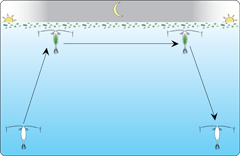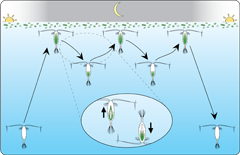 Forays and Foraging in Marine Zooplankton Forays and Foraging in Marine Zooplankton
Funded by NSF OCE
Diel Vertical Migration (DVM) is a well studied phenomenon in which zooplankton spend daylight hours in deep water, and rise to surface waters at night. Presumably this behavior minimizes predation by visually feeding fish but allows for the zooplankton to feed in the food-rich surface layers under cover of darkness.
Most studies of DVM rely on measurements of the distribution of organisms at particular points of time, which gives information on where the organisms are at those points in time, but not about their movements.
Our hypothesis is that throughout the night, zooplankton make short duration and short distance migrations in and out of food rich layers as a way to maximize food intake and minimize predation pressure.
 |
 |
Conceptual diagram of the canonical view of diel vertical migration (DVM). |
Conceptual diagram of Forays behavior (cf. Pearre 2003 and Johnson and Tarling 2006). |
We are testing this hypothesis by using "Z-Traps" to catch migrating zooplankton, and then analyzing individual zooplankters for gut contents, using image analysis and gut fluorescence techniques.
The sampling design for this study was derived from a modeling effort to explore how indiviudal behaviors affect vertical distribution of a vertically migrating copepod, Calanus pacificus (Leising et al 2005). In that study we tested how different foraging behaviors and physiological rates (grazing, digestion, swimming) could alter the observed vertical distributions. To do that, we created 1000 "virtual copepods", assigned them specific behaviors and rates, varied those rates among them, and then "sampled" them throughout the course of a model run. We compared these "virtual samples" with field observations to try to understand what actual copepods were doing. We were also able to use these "virtual samples" to help us determine what scale of sampling was necessary to tell the difference between upward migrating and downward migrating copepods in terms of physiological conditions - a necessary piece of information to address our hypothesis.
|

